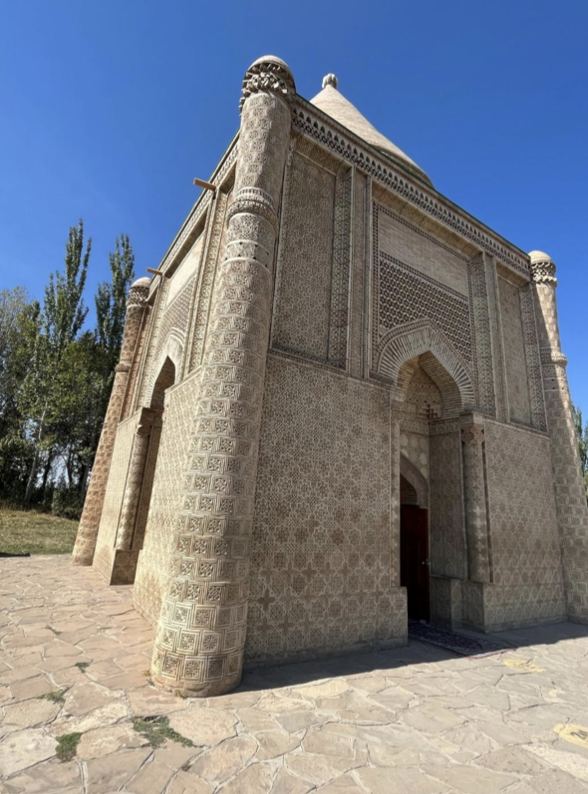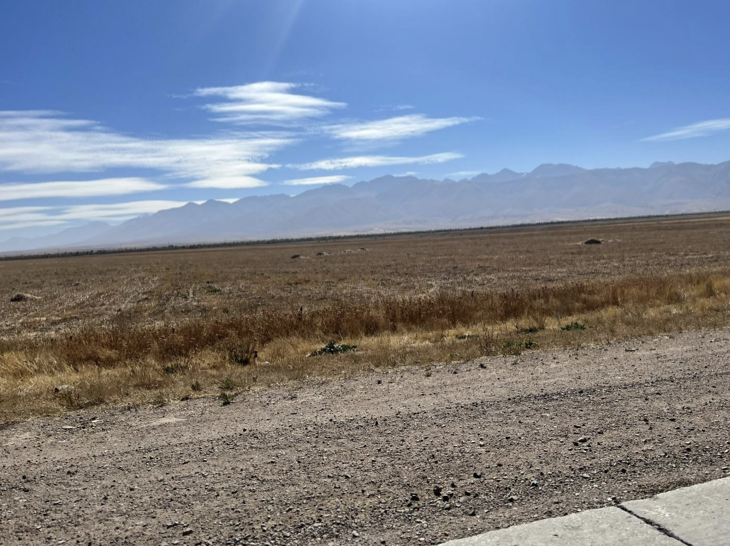By Fawzia Mai Tung
March/April 2023
Men die in the field, slashing sword to sword;
The horses of the conquered neigh piteously to Heaven.
Crows and hawks peck for human guts,
Carry them in their beaks and hang them on the branches of withered trees.
Captains and soldiers are smeared on the bushes and grass;
The General schemed in vain.
Know therefore that the sword is a cursed thing
Which the wise man uses only if he must.
— Fighting South of the Ramparts
Famed poet Li Bo (d.762) is believed
to be describing the Battle of Talas.
Islamic Horizons traveled to Talas, Kazakhstan, in search of this historic battle’s site.
As a Chinese Muslim, the five-day Battle of Talas, the sole Tang-Abbasid clash, has always fascinated me. According to historical descriptions, it occurred during July 751 CE, somewhere between the river Taraz (Talas) and the Tian Shan Mountain range. As we drove from Shymkent to Talas, my driver/guide suddenly said, “You wanted to know where the Battle of Talas happened? It’s somewhere over there,” waving his arm to the right, toward the distant peaks of the Talas Alatau range. “Where? Where?” I eagerly pulled out my phone. “There!” “Please, can we go there?” “How? There’s no road.” He was, however, kind enough to stop so I could take photos.
Astonishingly, this approximately millennium-old momentous battle remains shrouded in obscurity, its memory preserved only in poems. Some historians call it the “tenth largest and most important battle in history,” and yet most people outside Central Asia have never heard of it.

Why did the Abbasids choose the Tang as their first military target? Why was the mighty Tang army annihilated, and why was there no second engagement? Simply put, neither side had a feud or ax to grind and thus wanted to keep Transoxiana, a vital and strategic link on the mutually beneficial Silk Road, peaceful. Ancient China was powerful enough to stretch her influence to neighboring lands not by military conquest, but by exchanging protection for annual contributions.
During the early Tang dynasty, the Western Regions (the AnXi and MengChi protectorates), extended to the Aral Sea. Over the years, the central government figured out that small military garrisons couldn’t deal with the region’s constant strife and thus established a serious military presence. Its leaders were usually generals of ethnic minorities, part of the imperial policy to prevent potential political threats. Thus, in 751 General Guo XianZhi, commander of the Chinese forces in Ferghana, was of Korean origin.
The previous year, the Abbasids had replaced the Umayyads. Abu Muslim, leader of the Abbasid army and governor of Khurasan, was a highly intelligent freed Persian slave who had risen through the ranks. Further east, the fugitive son of the Chabish of Shesh (Chach), today’s Tashkent, sought help from Governor Ziyad ibn Salih of Samarkand and Bukhara.
The kingdoms of Shesh and Ferghana had been at war. The latter asked its Chinese protector for help, so Gao sacked Shesh, took its king prisoner and beheaded him (after promising safe passage), also killing thousands of its inhabitants and confiscating a large number of diamonds, gold and horses. The prince fled to Samarkand, setting the chessboard for a conflict between the eighth century’s two most powerful forces.
The area was then inhabited by nomadic Karluk Turks. Many of their divisions had received Chinese names as provinces, and their leaders’ Chinese titles. Some Karluk Turks allied with the Chinese army; a smaller number joined the Muslim army and/or other local allies such as Tibetan and Turgesh troops.
The accounts of the armies’ sizes vary greatly, from 20,000 to 200,000 for each side. Famed Song Dynasty historian Si MaQian guesstimates around 30,000 on the Chinese side. However, new material uncovered in 2004 hints at as many as 100,000 imperial, local and mercenary troops, a number that matches the Arab records of 100,000 Chinese versus 200,000 Abbasids. Modern historians lean toward 30,000 on each side, positing that the forces must have been nearly equally matched, given the battle’s development.
The battle itself has two scenarios. The most credible one states that the two armies faced each other, with the archers lined up in front. The Tang archers started shooting and quickly overcame the Abbasid archers due to superior technology. The next line, the spearmen or infantry, then advanced and fought. The Chinese had better armor and repulsed the Muslims. The Muslim cavalry on the flanks was then dispatched to alleviate the pressure on the infantry by attacking the Karluk cavalry. Gao sent in his reserve cavalry to attack as well. The day wore on, night came, everyone was exhausted and both sides withdrew to rest.
The same scenario repeated itself for three days. On the fourth day, a still-unexplained shocking twist occurred, one that some attributed to Ziyad ibn Salih: The Karluk Turk cavalry suddenly turned against their Chinese allies, attacked them from the flanks and launched an encirclement strategy. The Tang forces, exhausted and surprised, were nearly annihilated, although Gao and his closest officers managed to flee with a couple thousand troops.
Both generals died a few years later due to political intrigue. Despite the Muslims’ spectacular victory, the battle was considered a draw. Although more Tang troops were sent to the Western Regions to reinforce the borders, they were soon withdrawn because of the seven-year large-scale An-Shi Rebellion civil war that killed possibly up to 36 million people. Interestingly, the next caliph sent 3,000 mercenaries to help Emperor Xuan Zong quell the rebellion. Indeed, neither side was interested in further conflict.
The effects of the Battle of Talas (Atrakh) were far reaching. The Tangs lost interest in expanding westward, and the caliph sought to consolidate his power. The Karluk Turks grew in size and power, becoming the Tarim Basin’s main influence and established a khanate in 766. Historians report the presence of many craftsmen, especially silk weavers and paper makers, among the tens of thousands of Chinese prisoners. The weavers were sent to Kufa and the papermakers to Samarkand, where they eventually established a large paper-making industry that spread throughout the empire and later became an important part of Europe’s Renaissance and Protestantism’s spread. Other modern historians, however, scoff at this idea.

The effect of the Abbasids’ success was not immediately obvious. Over the next 250 years, Islam spread throughout Central Asia, overtaking the previous mixture of Zoroastrianism, Christianity, Tengrism, Buddhism, Manichaeism and Nestorian Christianity. In fact, some major Muslim figures hail from this area: Al-Khwarzimi (d.850), Abu Rayhan al-Biruni (d.1048), Al-Farabi (d.950), Ibn Sina (Avicenna; d.1198) and al-Bukhari (d.870). His mausoleum can be visited today near Samarkand.
Given this battle’s far-reaching effects, why are there no monuments or signs? The answer is really simple: The actual site is unknown. Historical records put it by the banks of the Talas River, about 10 miles from the fortress of Atrakh (the ancient name of Talas). Thus, it has generally been assumed that it occurred near Talas, Kazakhstan. However, Kyrgyz historian A. Kamyshev challenged this view in his September 2021 paper “The Consequences of One Mistake in the Localization of the City of Atlakh,” presented at the international Talas War and Its Historical Significance symposium. He claimed that Russian historian S. G. Klyashtorni was mistaken. Instead of “15 km [10 miles] to the west,” it should have been “15 km to the south,” thus placing the site in present-day Kyrgyzstan.
Kyrgyzstan has consolidated this opinion by building a monument on the Plain of Prokovka near Talas (same name, population of 40,000), in the Talas Region (same name), on May 27, 2021. The monument’s two pillars and circle crossed by triple lines symbolizes the tunduk, the central structure at the top of a yurt. This circle is said to represent the year 751, as it has a diameter of seven meters and a height of one meter.
On the other hand, Talas/Taraz, Kazakhstan, has a population of 400,000 and profuse archaeological evidence of ancient civilization. Given both cities’ — and countries’ — claims, the question of the battle’s exact location should probably be solved the way paternity issues are solved — hard facts, rather than assumptions of historical meanings. As many thousands of dead soldiers and horses are bound to have left their marks, there should be whole fields of spearheads, arrowheads — maybe even helmets and/or armor pieces.
Tourists can visit many sites, among them the Aisha Bibi mausoleum — dedicated to the memory of a beautiful girl whose father refused to let her marry the karakhan [ruler] because she was of prophetic descent; she died of a snake bite on her way to meet her lover in secret — many archaeological excavations; an underground cave where the Kazakhs hid during Dzungar raids; the oldest surviving minaret of Prophet Khyzyr/Khidhr; and even a mysterious and mystical Adam and Eve split rock that proves you are of pure heart if you can squeeze through it.
But for the legendary Battle of Talas, there is nothing but a vague “over there.”
Dr. Fawzia Mai Tung is executive director of Tung Education Resources; leader of Equity and Inclusion Team, the Society of Children’s Books Writers and Illustrators Arizona Chapter (SCBWI-AZ); and secretary of the executive board and translation team consultant, Dimash USA Fan Club.
Tell us what you thought by joining our Facebook community. You can also send comments and story pitches to horizons@isna.net. Islamic Horizons does not publish unsolicited material.
